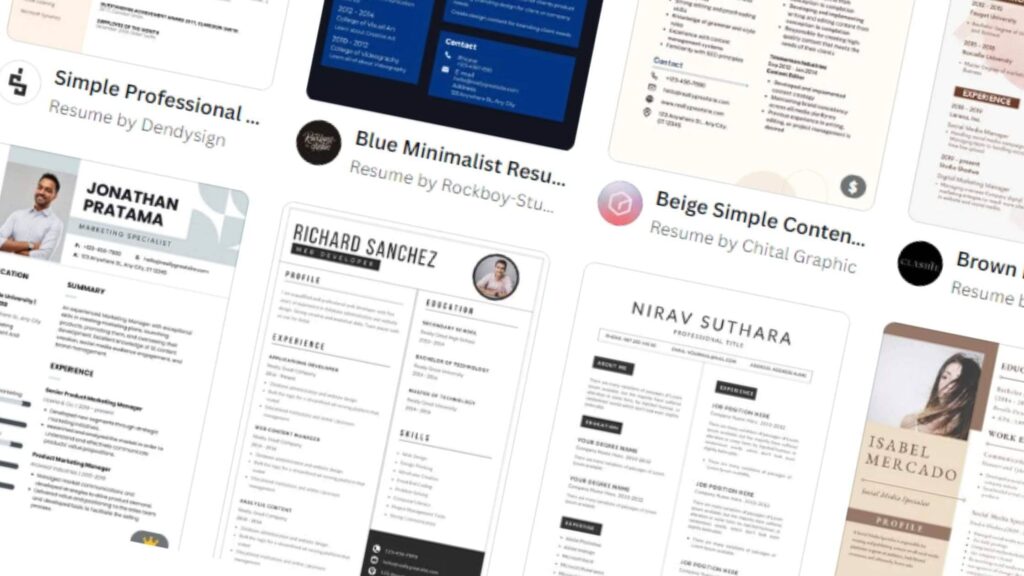Introduction: In today’s digital age, technology plays a significant role in various aspects of our lives, including the job search process. One area where technology has made a significant impact is in the evaluation of resumes. Automated systems, such as Applicant Tracking Systems (ATS) and Artificial Intelligence (AI), are increasingly being used by employers to streamline the hiring process. This article explores how technology, particularly AI and ATS, can affect your resume and provides insights on how you can optimize your resume to stand out in this digital landscape.
1. The Rise of Applicant Tracking Systems (ATS):

What is an ATS and how does it work?
An ATS, or Applicant Tracking System, is a software application used by employers to streamline the recruitment process and manage a large volume of job applications. It is designed to automate and simplify the initial screening and sorting of resumes received from candidates.
ATS works by parsing resumes and extracting relevant information such as contact details, work experience, education, skills, and qualifications. The system then stores this information in a structured format, allowing recruiters and hiring managers to search, filter, and rank candidates based on specific criteria.
ATS uses algorithms to analyze resumes and match them against job descriptions, identifying keywords, skills, and qualifications that are required for the position. Resumes that closely match the criteria are given higher rankings and are more likely to be reviewed by human recruiters. On the other hand, resumes that do not meet the specified criteria may be filtered out or placed lower in the ranking.
Understanding how an ATS works is crucial for job seekers as it helps them tailor their resumes to align with the system’s requirements, increasing their chances of passing the initial screening process and reaching the hands of hiring managers.
How ATS screens and filters resumes based on keywords and criteria.
ATS screens and filters resumes based on keywords and specific criteria set by the employer. The system uses algorithms to analyze the content of resumes and compare it to the job description. It scans for relevant keywords, skills, qualifications, and experience that match the requirements of the position. Resumes that contain the desired keywords and meet the specified criteria are given higher rankings and are more likely to be reviewed by human recruiters. On the other hand, resumes that do not meet the criteria may be filtered out or ranked lower. It is important for job seekers to optimize their resumes by including relevant keywords and tailoring their content to increase their chances of passing through the ATS screening process.
Tips for optimizing your resume for ATS compatibility.
To optimize your resume for ATS compatibility, there are a few key tips to keep in mind. –
- Firstly, ensure that you include relevant keywords and phrases throughout your resume that align with the job description. Use variations of these keywords naturally within the context of your skills, qualifications, and experience.
- Secondly, use a clean and simple resume format with standard fonts to ensure the ATS can easily read and parse the content. Avoid using images, graphics, or fancy formatting that may confuse the system.
- Lastly, proofread your resume to eliminate any spelling or grammatical errors that could hinder the ATS’s ability to accurately analyze your document.
By following these tips, you can increase the chances of your resume successfully passing through the ATS and reaching the hands of human recruiters.
2. The Influence of Artificial Intelligence (AI) in Resume Evaluation:

How AI is used to analyze and assess resumes.
AI is increasingly used to analyze and assess resumes in the hiring process. AI algorithms can quickly scan and parse resumes to extract relevant information and assess candidates’ qualifications. They can analyze factors such as work experience, education, skills, and keywords to determine the suitability of a candidate for a particular role. AI can also evaluate resumes for formatting, grammar, and readability. By using machine learning techniques, AI systems can learn from past hiring decisions and improve their assessment capabilities over time. This automated process saves time and effort for recruiters, allowing them to focus on reviewing the most promising candidates. However, it’s important to note that AI is a tool that supports decision-making and should be used in conjunction with human judgment to ensure fair and unbiased candidate evaluation.
The advantages and limitations of AI in the resume evaluation process.
AI in the resume evaluation process offers several advantages. Firstly, it can save a significant amount of time and effort for recruiters by automating the initial screening and evaluation of resumes. AI algorithms can quickly analyze a large number of resumes, extracting key information and assessing candidates’ qualifications. This efficiency allows recruiters to focus their time and attention on reviewing the most promising candidates. Additionally, AI can help reduce bias in the hiring process by evaluating candidates based on objective criteria rather than subjective judgments.
However, there are limitations to AI in resume evaluation. AI algorithms may not fully understand the context and nuances of certain roles or industries, leading to potential misinterpretation of qualifications. They may also struggle with understanding unconventional formats or creative resumes. Moreover, AI systems are only as effective as the data they are trained on, so biases in the training data can be reflected in the evaluation process. Additionally, AI cannot assess soft skills or interpersonal qualities that are crucial for certain roles. Therefore, it’s important to use AI as a tool in conjunction with human judgment to ensure a comprehensive and fair evaluation of candidates.
Strategies for tailoring your resume to appeal to AI algorithms.
To optimize your resume for AI algorithms, there are several strategies you can employ. Firstly, ensure that your resume includes relevant keywords and phrases that are commonly used in the job description. This helps the AI algorithm identify your qualifications and match them to the desired criteria. Additionally, use a clean and standardized resume format with clear section headings and bullet points. This helps the algorithm extract and understand the information more easily. Avoid using graphics, images, or unconventional formatting that may confuse the AI. Lastly, focus on highlighting your relevant skills and experiences that directly align with the job requirements, as this increases the chances of your resume being flagged as a match by the AI algorithm.
3. Key Considerations for Resume Writing in the Digital Age:

Balancing human appeal and machine-readability in your resume.
Balancing human appeal and machine-readability in your resume is crucial for success in today’s job market. While it’s important to optimize your resume for ATS compatibility, you should also consider the human aspect of resume evaluation. Ensure that your resume is visually appealing, well-organized, and easy to read by human recruiters. Use clear and concise language, highlight your accomplishments, and showcase your unique qualifications. Strike a balance between using industry-specific keywords for AI algorithms and conveying your skills and experiences in a compelling way for human readers. By considering both the needs of the ATS and the preferences of human recruiters, you can create a resume that stands out to both machines and human evaluators alike.
The importance of incorporating relevant keywords and skills.
The importance of incorporating relevant keywords and skills in your resume cannot be overstated. Including specific keywords and skills that are relevant to the job you’re applying for helps your resume get noticed by both ATS systems and human recruiters. These keywords are often used by employers to filter out resumes that don’t meet their specific criteria. By tailoring your resume to include these keywords, you demonstrate that you have the desired qualifications and experience for the role. Additionally, incorporating relevant skills helps you showcase your expertise and demonstrate that you have the necessary capabilities to excel in the position. Therefore, it’s essential to carefully review the job description and incorporate relevant keywords and skills throughout your resume to maximize your chances of success.
Formatting and design tips to ensure compatibility with digital systems.
When it comes to formatting and design, it’s important to ensure compatibility with digital systems, including ATS and AI algorithms. Here are some tips to consider:
- Use a clean and professional layout: Opt for a simple and organized design that is easy to read and navigate. Avoid complex formatting, excessive graphics, or unusual fonts that may not be compatible with digital systems.
- Use standard file formats: Save your resume in a commonly accepted format such as PDF or Word (.doc or .docx) to ensure compatibility across different platforms.
- Optimize headings and sections: Clearly label each section of your resume with standard headings such as “Work Experience,” “Education,” and “Skills.” This helps digital systems identify and categorize the information accurately.
- Use standard fonts and font sizes: Stick to standard fonts like Arial, Calibri, or Times New Roman in a legible font size (11 or 12 points) to ensure readability across different systems.
Avoid complex tables and graphics: While visual elements can enhance the design, avoid using intricate tables, graphs, or images that may not be parsed correctly by ATS systems.
By following these formatting and design tips, you can ensure that your resume is compatible with digital systems, increasing the chances of it being properly processed and evaluated by both machines and human recruiters.
4. The Impact on Job Seekers and Hiring Practices:

How technology has reshaped the recruitment landscape.
Technology has significantly reshaped the recruitment landscape, revolutionizing how employers and candidates connect. With the advent of applicant tracking systems (ATS), artificial intelligence (AI), and online platforms, the recruitment process has become more efficient and streamlined. Technology enables automated resume screening, keyword matching, and data-driven candidate assessments, saving time and effort for both recruiters and applicants. It has also facilitated remote interviewing and virtual hiring, breaking down geographical barriers and expanding the talent pool. However, it’s important to strike a balance between technology and the human touch in the recruitment process to ensure fair and unbiased candidate evaluations. Overall, technology has transformed recruitment, making it faster, more accessible, and data-driven, ultimately shaping a new era of talent acquisition.
Advantages and challenges for job seekers in the age of technology.
The age of technology has brought both advantages and challenges for job seekers. On the positive side, technology has made job searching more convenient and accessible. Online job portals and professional networking platforms provide a vast array of job opportunities and the ability to connect with employers directly. Additionally, technology has made it easier to research companies, learn about industry trends, and enhance professional skills through online courses and resources.
However, there are also challenges. The increased use of applicant tracking systems (ATS) means that resumes need to be optimized for digital screening, which can be a hurdle for some job seekers. The reliance on online applications and digital assessments may limit the personal connection with employers. Moreover, the competition for jobs has intensified as technology has enabled a larger pool of applicants from around the world.
To navigate these challenges, job seekers must stay updated with technology trends, tailor their resumes for ATS, leverage online networking platforms, and continuously upskill to stand out in a competitive job market.
The evolving role of recruiters and HR professionals in the digital era.
The digital era has brought significant changes to the role of recruiters and HR professionals. Technology has streamlined and automated various aspects of the recruitment process, allowing recruiters to focus more on strategic decision-making and building relationships with candidates. With the help of applicant tracking systems (ATS), recruiters can efficiently screen resumes, identify qualified candidates, and manage the hiring process more effectively. Additionally, digital tools enable HR professionals to engage with candidates through online platforms, conduct virtual interviews, and assess skills remotely. However, the human touch remains crucial in the recruitment process, as recruiters and HR professionals play a vital role in evaluating cultural fit, assessing soft skills, and providing a personalized experience to candidates. They also have the responsibility of adapting to new technologies, staying updated with industry trends, and leveraging data analytics to make informed decisions.
5. Strategies For Success:

Researching industry-specific ATS requirements and resume trends.
Researching industry-specific ATS requirements and resume trends is essential for job seekers in today’s competitive job market. Different industries may have specific keywords, skills, or formatting preferences that ATS systems prioritize when scanning resumes. By understanding these requirements, job seekers can tailor their resumes accordingly, increasing their chances of passing through the initial screening process. Additionally, staying updated on resume trends helps job seekers align their resumes with current industry standards and best practices. This includes aspects such as incorporating relevant achievements, showcasing transferable skills, and utilizing a clean and visually appealing resume layout. By conducting thorough research on industry-specific ATS requirements and resume trends, job seekers can optimize their resumes to effectively capture the attention of both ATS systems and human recruiters, improving their chances of landing job interviews.
Customizing your resume for each application.
Customizing your resume for each application is a crucial step in the job search process. While it may take more time and effort, tailoring your resume to align with the specific job requirements and company needs can greatly increase your chances of standing out among other candidates. By carefully reviewing the job description, researching the company, and understanding the desired qualifications, you can highlight the most relevant skills, experiences, and achievements that directly match the job requirements. Customization allows you to showcase your suitability for the specific role and demonstrate your genuine interest in the position. This personalized approach not only helps your resume pass through ATS systems but also resonates with hiring managers, making a strong impression and increasing your likelihood of securing an interview.
Showcasing your skills and achievements effectively to stand out from the competition.
To stand out from the competition, it is essential to showcase your skills and achievements effectively on your resume. Rather than simply listing your responsibilities, focus on highlighting the impact and results you achieved in previous roles. Quantify your achievements whenever possible to provide concrete evidence of your abilities. Use action verbs and specific details to make your accomplishments more compelling. Additionally, emphasize relevant skills that align with the job requirements, using keywords that resonate with the hiring manager. By presenting your skills and achievements in a clear and concise manner, you can demonstrate your value and unique contributions, making your resume more memorable and increasing your chances of securing an interview.
6. Future Trends in Resume Technology:

Predictions on the future of resume evaluation and job search process.
The future of resume evaluation and the job search process is expected to be shaped by advancements in technology. Artificial intelligence (AI) and machine learning algorithms are likely to play a more prominent role in resume screening and candidate selection. These technologies can analyze resumes more efficiently, identifying relevant skills and qualifications. Additionally, the rise of online platforms and professional networking sites may lead to increased reliance on digital profiles and portfolios. Job seekers should anticipate the need for continuous learning and adaptability as new technologies emerge. Personal branding and online presence will become even more critical in distinguishing oneself in a competitive job market. Overall, the future is likely to bring a more streamlined and tech-driven approach to resume evaluation and job search, requiring candidates to stay updated on emerging trends and strategies.
The role of emerging technologies like machine learning and natural language processing.
Emerging technologies like machine learning and natural language processing have a significant impact on resume evaluation and the job search process. Machine learning algorithms can analyze vast amounts of data to identify patterns and trends in resumes, helping recruiters quickly identify qualified candidates. Natural language processing enables the system to understand and interpret the content of resumes, extracting relevant information and keywords. These technologies enable more efficient and accurate resume screening, saving time and effort for both job seekers and recruiters. By leveraging machine learning and natural language processing, organizations can streamline their hiring processes and make data-driven decisions. Job seekers can benefit from understanding how these technologies work and optimizing their resumes to align with the requirements of these automated systems.
Implications for job seekers in adapting to upcoming resume technology trends.
Adapting to upcoming resume technology trends is crucial for job seekers to stay competitive in the evolving job market. Understanding how resume evaluation technologies like ATS and AI work and incorporating relevant keywords and skills in their resumes can increase their chances of getting noticed by automated systems. Job seekers should also focus on showcasing their unique skills and achievements in a clear and concise manner to stand out from the competition. Additionally, staying updated on industry-specific ATS requirements and resume trends is essential to tailor their resumes effectively. By embracing these technology-driven changes and optimizing their resumes accordingly, job seekers can enhance their chances of securing interviews and landing their desired roles.
Conclusion:
As technology continues to advance, it is crucial for job seekers to understand how it affects the evaluation of their resumes. By optimizing their resumes for ATS compatibility, incorporating relevant keywords, and keeping up with the latest trends, candidates can increase their chances of standing out in the digital job market. While technology brings new challenges, it also opens doors to opportunities and allows for a more efficient hiring process. By embracing these changes and adapting their resume strategies accordingly, job seekers can navigate the evolving landscape and enhance their chances of landing their desired roles. You can also consult with a career advisor or counselor, where Vati has come up with an AI-driven career assessment platform. Vati provides a comprehensive career assessment platform that connects individuals with industry experts and experienced resume design professionals in a single platform. With their wealth of knowledge and guidance, you can gain valuable insights into the potential outcomes of entering specific industries.





